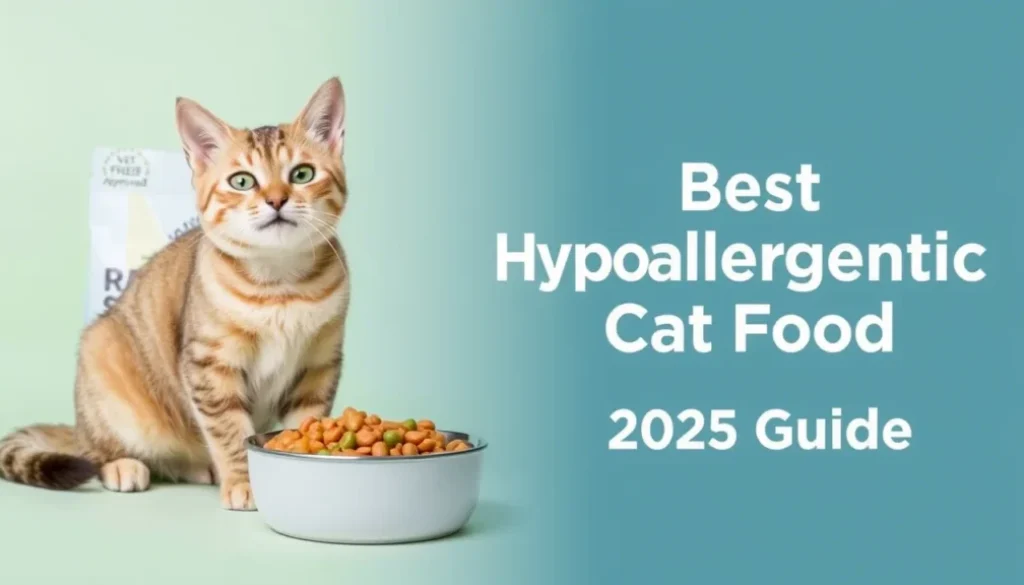Hypo Allergenic Cat Food: A Complete Guide for Sensitive Cats
If your feline friend is constantly scratching, dealing with digestive issues, or suffering from skin irritations, they might have a food allergy or intolerance. One of the best solutions for such problems is switching to hypo allergenic cat food. In this guide, we’ll explore everything you need to know about hypoallergenic diets for cats, including what to look for, top brands, and how to transition your cat safely.
What Is Hypo Allergenic Cat Food?
Hypo allergenic cat food is specially formulated to minimize the risk of allergic reactions in cats. It typically contains:
- Limited ingredients to reduce exposure to potential allergens
- Novel protein sources (like duck, venison, or rabbit)
- No artificial additives, preservatives, or grains
- Hydrolyzed proteins in some prescription formulas
Unlike regular cat food, hypoallergenic options are designed for cats with food sensitivities or allergies that manifest as skin issues, vomiting, or chronic diarrhea.
Check this article Top 10 Most Popular Cat Breeds in Australia
Common Signs of Food Allergies in Cats
Before switching to hypo allergenic cat food, it’s crucial to recognize the signs of a possible food allergy:
- Itchy skin or excessive grooming
- Hair loss or rashes
- Chronic ear infections
- Frequent vomiting or diarrhea
- Swollen paws or skin inflammation
If you notice any of these symptoms, it’s wise to consult your veterinarian before changing your cat’s diet.
Common Cat Food Allergen
Cats can be allergic to various ingredients commonly found in commercial pet food. Here’s a list of frequent culprits:
- Chicken
- Beef
- Fish
- Dairy
- Corn
- Soy
- Wheat and other grains
- Artificial colorings or preservatives
A hypo allergenic cat food formula will typically avoid these ingredients and replace them with more digestible alternatives.
Top Ingredients in Hypoallergenic Cat Food
| Ingredient | Purpose |
|---|---|
| Hydrolyzed Chicken | Prevents immune system recognition |
| Duck or Rabbit | Novel protein sources |
| Sweet Potatoes | Grain-free carbohydrate source |
| Omega-3 Fatty Acids | Reduces skin inflammation |
| Probiotics | Supports gut health |
Types of Hypo Allergenic Cat Food
There are several types of hypoallergenic diets available, depending on your cat’s needs and the severity of the allergy:
1. Limited Ingredient Diet (LID)
These foods include only a few essential ingredients, typically featuring a single protein and carbohydrate source.
2. Novel Protein Diets
These contain proteins that your cat has likely never eaten before, such as rabbit, venison, or duck.
3. Hydrolyzed Protein Diets
In these, proteins are broken down into smaller components to avoid triggering an allergic response. Often available only with a prescription.
Best Hypo Allergenic Cat Food Brands (2025 Picks)
Here’s a comparison table of some of the most trusted and veterinarian-recommended hypoallergenic cat food brands:
| Brand | Protein Source | Type | Key Features | Price Range |
|---|---|---|---|---|
| Hill’s Prescription Diet z/d | Hydrolyzed Chicken | Prescription | Clinically proven for food sensitivities | $$$ |
| Royal Canin Hydrolyzed Protein | Hydrolyzed Soy Protein | Prescription | Highly digestible and vet recommended | $$$ |
| Blue Buffalo Basics | Turkey or Duck | Limited Ingredient Diet | Grain-free, no chicken or beef | $$ |
| Natural Balance LID | Salmon, Duck, Venison | Limited Ingredient Diet | Single protein, no fillers or grains | $$ |
| Instinct Limited Ingredient | Rabbit or Turkey | Limited Ingredient Diet | Freeze-dried raw coated kibble | $$ |
Tips for Choosing the Right Hypo Allergenic Cat Food
Here are some quick tips to help you make the best choice:
- Read the label carefully: Look for foods with clearly listed ingredients and no fillers or additives.
- Start with a novel protein: If your cat has eaten chicken or beef before, try something new like rabbit or duck.
- Avoid grain and soy: Choose grain-free options to minimize allergen exposure.
- Check for AAFCO approval: Ensure the food meets the standards set by the Association of American Feed Control Officials.
- Consult your vet: Always discuss dietary changes with your veterinarian, especially if symptoms are severe.
How to Transition Your Cat to Hypo Allergenic Food
Transitioning to a new diet should be gradual to avoid upsetting your cat’s digestive system. Follow this 7-day plan:
- Days 1–2: Mix 75% old food with 25% new food
- Days 3–4: Mix 50% old food with 50% new food
- Days 5–6: Mix 25% old food with 75% new food
- Day 7: 100% new food
Watch closely for any signs of improvement or new reactions during this period.
Benefits of Hypo Allergenic Cat Food
Switching to hypo allergenic cat food can provide several health benefits:
- Improved skin and coat: Less itching, shinier fur
- Better digestion: Reduced vomiting and diarrhea
- More energy: Allergies can cause lethargy, so improvement may be noticeable
- Weight control: Limited ingredient diets may help manage weight better
Real-Life Success Story
“My Siamese cat, Luna, had horrible skin issues for months. We tried everything until our vet suggested a hypoallergenic diet. Within two weeks on a limited ingredient rabbit formula, her itching stopped and her coat looked amazing! It was a game changer.”
— Sarah K., Cat Owner from Texas
Top Hypo Allergenic Cat Food Products (2025 Recommendations)
Below are some of the most trusted and veterinarian-recommended products currently available on the market. These foods are either limited ingredient, novel protein, or prescription formulas designed specifically for cats with food sensitivities or allergies.
1. Hill’s Prescription Diet z/d Original Skin/Food Sensitivities
- Type: Prescription, Hydrolyzed Protein
- Main Ingredient: Hydrolyzed chicken liver
- Why it’s great: Clinically proven to help reduce food-related skin and gastrointestinal issues.
- Best for: Severe allergies with vet recommendation
- Where to buy: Chewy, Amazon
2. Royal Canin Veterinary Diet Hydrolyzed Protein
- Type: Prescription, Hydrolyzed Protein
- Main Ingredient: Hydrolyzed soy protein isolate
- Why it’s great: Excellent for long-term management of food intolerance; helps maintain skin and coat health.
- Best for: Cats with chronic digestive issues or dermatitis
- Where to buy: Chewy, Petco
3. Blue Buffalo Basics Limited Ingredient Diet (LID) – Turkey & Potato
- Type: Non-prescription, Limited Ingredient Diet
- Main Ingredient: Deboned turkey
- Why it’s great: Budget-friendly LID with no grains, dairy, or chicken by-products.
- Best for: Mild to moderate sensitivities
- Where to buy: Amazon, PetSmart
4. Instinct Limited Ingredient Diet Grain-Free Recipe with Real Rabbit
- Type: Limited Ingredient Diet
- Main Ingredient: Cage-free rabbit
- Why it’s great: High-protein, raw-coated kibble with no grains or dairy.
- Best for: Cats needing a novel protein source
- Where to buy: Instinctpetfood.com, Amazon
4. Natural Balance L.I.D. Salmon & Green Pea Formula
- Type: Limited Ingredient, Non-prescription
- Main Ingredient: Salmon
- Why it’s great: Simple formula that supports healthy skin and digestion.
- Best for: Everyday maintenance for sensitive cats
- Where to buy: Chewy, Walmart
Natural Remedies for Cats With Food Allergies
If you’re looking for more holistic or supportive options alongside hypo allergenic cat food, here are natural solutions that may help alleviate allergic symptoms.
1. Omega-3 Fatty Acids (Fish Oil)
- Benefits: Reduces inflammation, soothes skin, improves coat health
- How to use: Add to food daily (vet-approved dosage)
- Example Product: Nordic Naturals Omega-3 Pet, Grizzly Salmon Oil
2. Probiotics
- Benefits: Promotes gut health and strengthens the immune system
- How to use: Mix into food or use cat-specific probiotic treats
- Example Product: Purina FortiFlora, Pet Ultimates Cat Probiotics
3. Aloe Vera Spray (Topical Use Only)
- Benefits: Soothes itchy or irritated skin
- Note: Use only vet-recommended pet-safe sprays. Do not use raw aloe orally—it’s toxic to cats.
4. Quercetin (Natural Antihistamine)
- Benefits: Acts like Benadryl for pets, reducing allergic reactions
- How to use: Available in pet-safe supplements; consult vet for dosage
- Example Product: VetriScience Derma-Strength
5. Colloidal Oatmeal Baths
- Benefits: Relieves skin itchiness and irritation
- When to use: For cats willing to tolerate bathing, especially during flare-ups
6. Chamomile Tea Compress
- Benefits: Natural anti-inflammatory
- How to use: Brew, cool, and apply topically to affected areas with a cotton pad
⚠️ Important Reminder: Always consult your vet before introducing supplements or natural remedies, especially if your cat is on medication or has underlying health issues.
FAQs: Hypo Allergenic Cat Food
1. What makes cat food hypoallergenic?
Hypoallergenic cat food contains limited or novel ingredients and avoids common allergens like chicken, beef, dairy, and grains. Some use hydrolyzed proteins that are less likely to trigger an immune response.
2. Do I need a prescription for hypoallergenic cat food?
Some formulas, like those with hydrolyzed proteins, require a veterinary prescription. However, many over-the-counter limited ingredient diets are also effective.
3. How long does it take to see results after switching?
You may notice improvements within 2 to 4 weeks, though some cats might take longer. Track symptoms and consult your vet regularly during the transition.
4. Can I feed hypoallergenic food to a healthy cat?
Yes, but it’s not necessary unless your cat has allergies or sensitivities. Always consult your vet before switching diets without a medical reason.
5. Is grain-free the same as hypoallergenic?
Not exactly. While grain-free food eliminates one potential allergen, true hypoallergenic food avoids multiple known allergens and often uses novel proteins or hydrolyzed ingredients.
6. Can wet cat food be hypoallergenic too?
Absolutely. Many brands offer hypoallergenic wet food formulas that are ideal for cats who prefer moist diets or need higher hydration levels.
Final Thoughts
Finding the right hypo allergenic cat food for your feline companion can significantly improve their quality of life. Whether you go with a limited ingredient, novel protein, or hydrolyzed formula, always prioritize your cat’s unique health needs and consult with your veterinarian for the best results. A happier, healthier kitty starts with the right nutrition!
You May Also Like:
1. 9 Ways to Reduce Cat Allergens in Your Home





Best Cat Food for Cats with Allergies: A Complete 2025 Guide - EmzillaTech - Best Pet Food Reviews & Expert Advice
May 20, 2025 @ 5:46 pm
[…] You may like: Hypo Allergenic Cat Food: A Complete Guide for Sensitive Cats […]